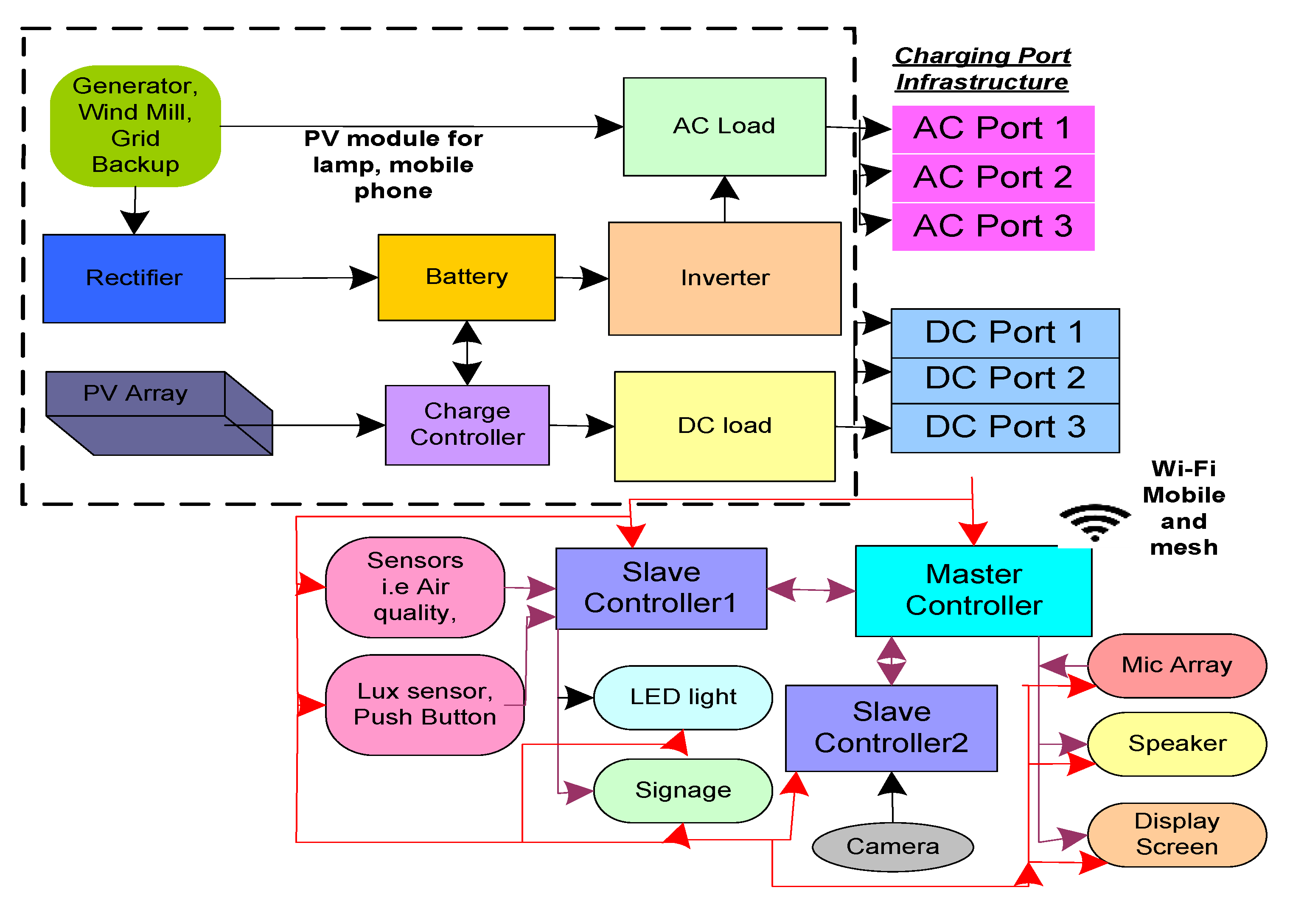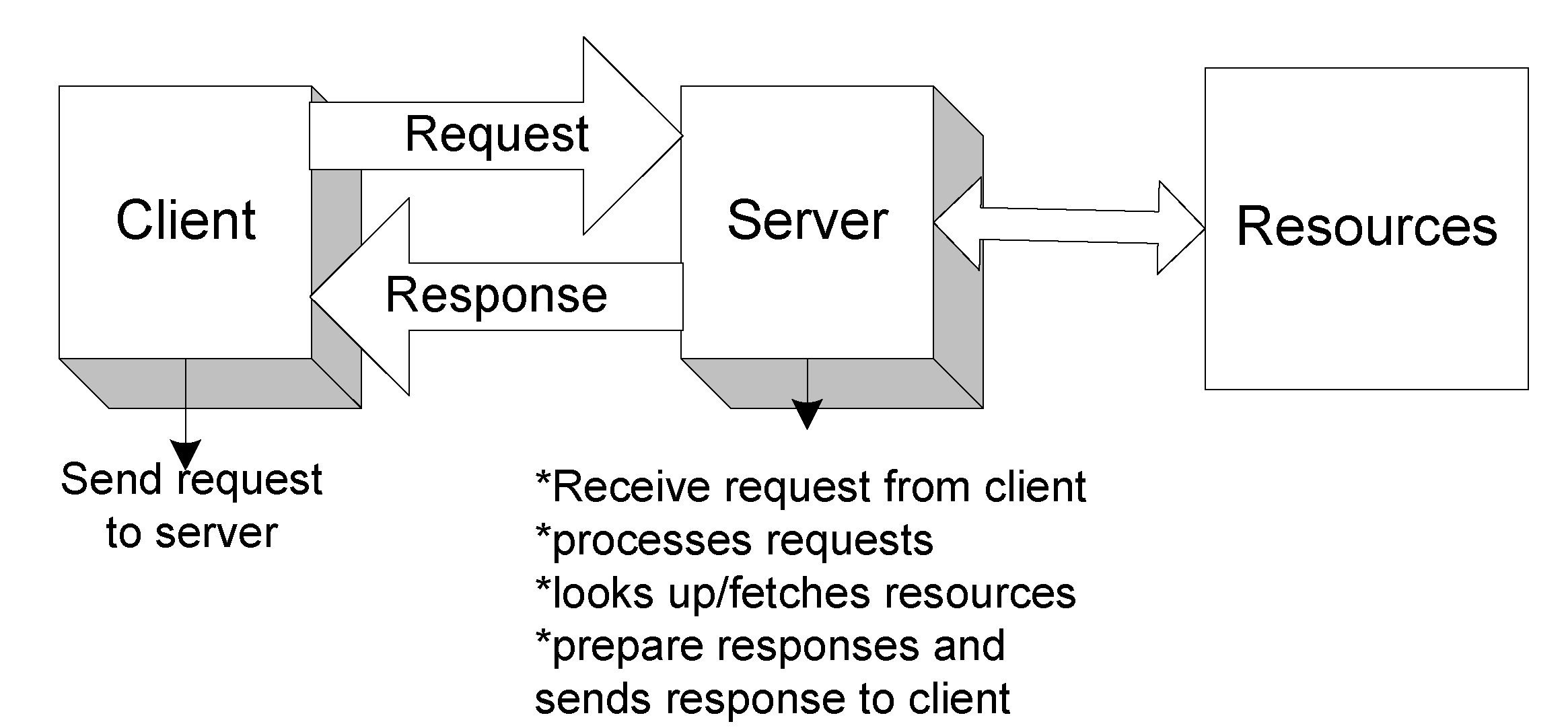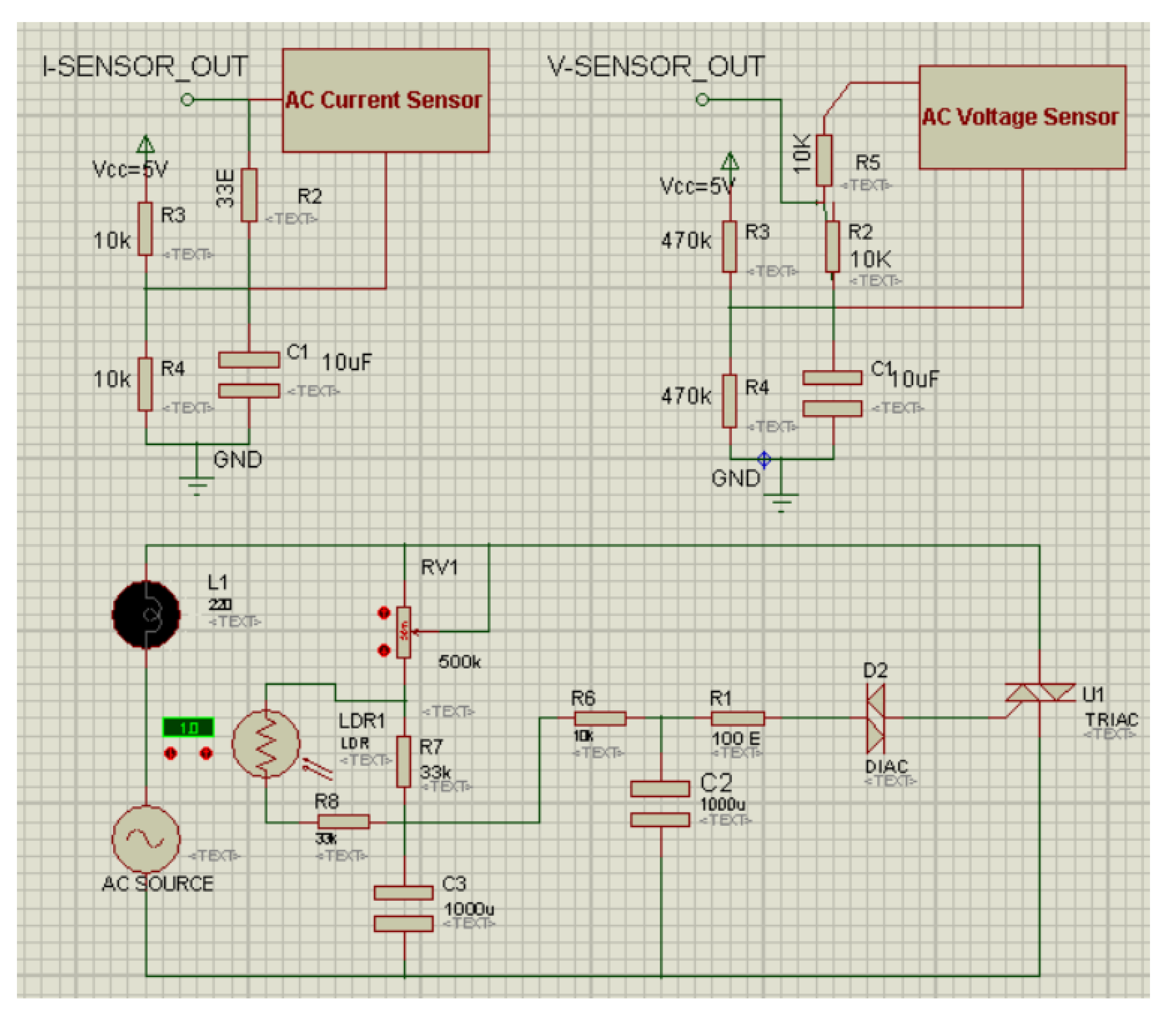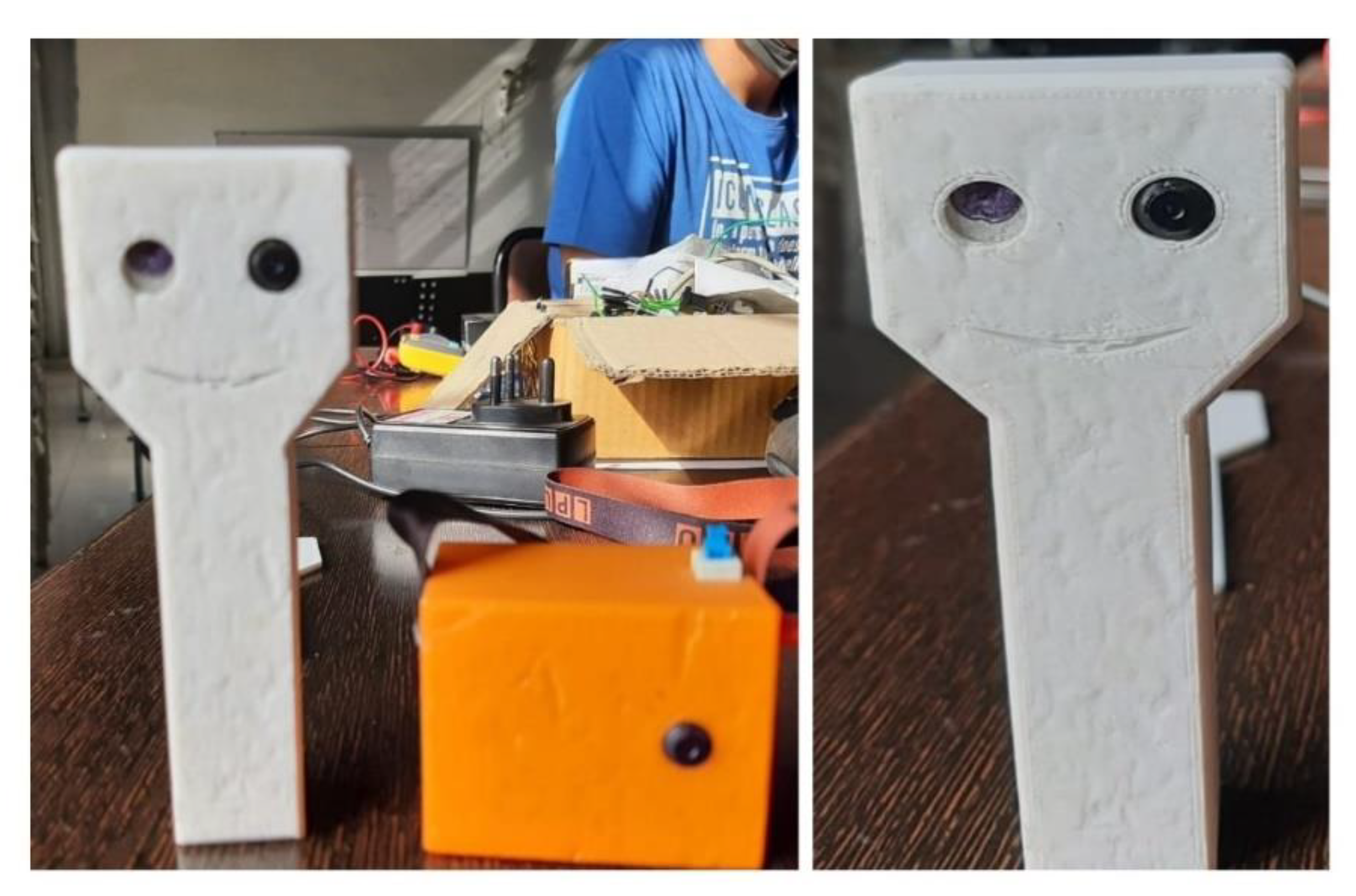Internet of Things and Long-Range-Based Smart Lampposts for Illuminating Smart Cities
Abstract
1. Introduction
- a.
- IoT server assisted fog and edge-based architecture is proposed for smart lampposts.
- b.
- Smart lampposts are integrated with low power and long-range communication, i.e., Long-Range, enabling the smart lamppost to communicate the sensory data to a long-range.
- c.
- LoRa is integrated with a Wi-Fi module for establishing the interconnection between the smart lamppost and IoT server.
- d.
- The proposed architecture is broad perspective; we have designed and implemented three components, namely, lighting system, environment parameter monitoring and image sensing in real time environment.
- e.
- A hybrid system is implemented for monitoring the lighting system, environment parameter monitoring and, moreover, the sensing values of these components are plotted in the graph.
- f.
- Master and slave controller-based mechanism is implemented for the intercommunicating the components of smart lampposts.
- g.
- A proteus simulation is performed for the smart lighting system.
- h.
- The working of developed image sensing prototype based on ESP 32 is also discussed in the study with real-time implementation results.
2. Related Works and Overview of IoT
2.1. Related Works
2.2. Overview of IoT
3. Proposed Smart Lamppost Architecture
4. Hardware and Software Description
4.1. Hardware Description:
4.2. Software Development
5. Simulation of Smart Lighting System
6. Results and Discussion
7. Conclusions
Author Contributions
Funding
Institutional Review Board Statement
Informed Consent Statement
Data Availability Statement
Conflicts of Interest
References
- 68% of the World Population Projected to Live in Urban Areas by 2050, Says UN|UN DESA|United Nations Department of Economic and Social Affairs. Available online: https://www.un.org/development/desa/en/news/population/2018-revision-of-world-urbanization-prospects.html (accessed on 19 March 2021).
- Bibri, S.E.; Krogstie, J. Smart sustainable cities of the future: An extensive interdisciplinary literature review. In Sustainable Cities and Society; Elsevier: Amsterdam, The Netherlands, 2017; Volume 31, pp. 183–212. [Google Scholar] [CrossRef]
- Angelidou, M.; Psaltoglou, A.; Komninos, N.; Kakderi, C.; Tsarchopoulos, P.; Panori, A. Enhancing sustainable urban development through smart city applications. J. Sci. Technol. Policy Manag. 2018, 9, 146–169. [Google Scholar] [CrossRef]
- Mattoni, B.; Gugliermetti, F.; Bisegna, F. A multilevel method to assess and design the renovation and integration of Smart Cities. Sustain. Cities Soc. 2015, 15, 105–119. [Google Scholar] [CrossRef]
- Novotný, R.; Kuchta, R.; Kadlec, J. Smart city concept, applications and services. J. Telecommun. Syst. Manag. 2014, 3, 117. [Google Scholar]
- Smith, S.F. Smart infrastructure for future urban mobility. AI Mag. 2020, 41, 5–18. [Google Scholar] [CrossRef]
- Ramamoorthy, S.; Kowsigan, M.; Balasubramanie, P.; Paul, P.J. Smart City Infrastructure Management System Using IoT. In Role of Edge Analytics in Sustainable Smart City Development; Wiley: Hoboken, NJ, USA, 2020; pp. 127–138. [Google Scholar]
- Anguraj, D.K.; Balasubramaniyan, S.; Saravana Kumar, E.; Vakula Rani, J.; Ashwin, M. Internet of things (IoT)-based unmanned intelligent street light using renewable energy. Int. J. Intell. Unmanned Syst. 2021. [Google Scholar] [CrossRef]
- Escolar, S.; Carretero, J.; Marinescu, M.-C.; Chessa, S. Estimating energy savings in smart street lighting by using an adaptive control system. Int. J. Distrib. Sens. Netw. 2014, 10, 971587. [Google Scholar] [CrossRef]
- Masoud, M.I. Street lighting using solar powered LED light technology: Sultan Qaboos University Case Study. In Proceedings of the 2015 IEEE 8th GCC Conference & Exhibition, Muscat, Oman, 1–4 February 2015; pp. 1–6. [Google Scholar]
- Liu, G. Sustainable feasibility of solar photovoltaic powered street lighting systems. Int. J. Electr. Power Energy Syst. 2014, 56, 168–174. [Google Scholar] [CrossRef]
- Cellucci, L.; Burattini, C.; Drakou, D.; Gugliermetti, F.; Bisegna, F.; Vollaro, A.D.L.; Salata, F.; Golasi, I. Urban lighting project for a small town: Comparing citizens and authority benefits. Sustainability 2015, 7, 14230–14244. [Google Scholar] [CrossRef]
- Khalil, A.; Rajab, Z.; Amhammed, M.; Asheibi, A. The benefits of the transition from fossil fuel to solar energy in Libya: A street lighting system case study. Appl. Sol. Energy 2017, 53, 138–151. [Google Scholar] [CrossRef]
- Signify. Smart Street Lighting for Smart (er) Cities; Signify: Eindhoven, The Netherlands, 2020. [Google Scholar]
- Yoomak, S.; Ngaopitakkul, A. Optimisation of lighting quality and energy efficiency of LED luminaires in roadway lighting systems on different road surfaces. Sustain. Cities Soc. 2018, 38, 333–347. [Google Scholar] [CrossRef]
- Dizon, E.; Pranggono, B. Smart streetlights in Smart City: A case study of Sheffield. J. Ambient Intell. Humaniz. Comput. 2021, 1, 3. [Google Scholar] [CrossRef]
- Zhang, Y.; Zhuo, X.; Guo, W.; Wang, X.; Zhao, Z. Lighting Environment Optimization of Highway Tunnel Entrance Based on Simulation Research. Int. J. Environ. Res. Public Health 2019, 16, 2195. [Google Scholar] [CrossRef] [PubMed]
- Vega, C.P.; Zielinska-Dabkowska, K.M.; Hölker, F. Urban lighting research transdisciplinary framework—A collaborative process with lighting professionals. Int. J. Environ. Res. Public Health 2021, 18, 624. [Google Scholar] [CrossRef]
- Umamaheswari, S. Smart street lighting in smart cities: A transition from traditional street lighting. In Studies in Systems, Decision and Control; Springer Science and Business Media Deutschland GmbH: Berlin/Heidelberg, Germany, 2021; Volume 308, pp. 117–133. [Google Scholar]
- Asghari, P.; Rahmani, A.M.; Javadi, H.H.S. Internet of Things applications: A systematic review. Comput. Netw. 2019, 148, 241–261. [Google Scholar] [CrossRef]
- Ahad, M.A.; Paiva, S.; Tripathi, G.; Feroz, N. Enabling technologies and sustainable smart cities. Sustain. Cities Soc. 2020, 61, 102301. [Google Scholar] [CrossRef]
- Zanella, A.; Bui, N.; Castellani, A.; Vangelista, L.; Zorzi, M. Internet of things for smart cities. IEEE Internet Things J. 2014, 1, 22–32. [Google Scholar] [CrossRef]
- Sikder, A.K.; Acar, A.; Aksu, H.; Uluagac, A.S.; Akkaya, K.; Conti, M. IoT-enabled smart lighting systems for smart cities. In Proceedings of the 2018 IEEE 8th Annual Computing and Communication Workshop and Conference (CCWC), Las Vegas, NV, USA, 8–10 January 2018; pp. 639–645. [Google Scholar]
- Kumar, A.; Kar, P.; Warrier, R.; Kajale, A.; Panda, S.K. Implementation of smart LED lighting and efficient data management system for buildings. Energy Procedia 2017, 143, 173–178. [Google Scholar] [CrossRef]
- Velaga, N.R.; Kumar, A. Techno-economic Evaluation of the Feasibility of a Smart Street Light System: A case study of Rural India. Procedia Soc. Behav. Sci. 2012, 62, 1220–1224. [Google Scholar] [CrossRef]
- Malhotra, S.; Kumar, V. Smart Street Lighting System: An Energy Efficient Approach. Int. J. Sci. Res. 2016, 5, 1082–1085. [Google Scholar] [CrossRef]
- Yoshiura, N. Smart street light system based on IoT. In Proceedings of the International Conference on Technology and Social Science, Online, 2–4 December 2020; Available online: http://conf.e-jikei.org/ICTSS/2020/ (accessed on 1 March 2021).
- Doulos, L.T.; Sioutis, I.; Kontaxis, P.; Zissis, G.; Faidas, K. A decision support system for assessment of street lighting tenders based on energy performance indicators and environmental criteria: Overview, methodology and case study. Sustain. Cities Soc. 2019, 51, 101759. [Google Scholar] [CrossRef]
- Donatello, S.; Rodríguez, R.; Quintero, M.G.C.; JRC, O.W.; Van Tichelen, P.; Van, V.; Hoof, T.G.V. Revision of the EU Green Public Procurement Criteria for Road Lighting and Traffic Signals; Publications Office of the European Union: Luxembourg, 2019; p. 127. [Google Scholar]
- Shahzad, K.; Čuček, L.; Sagir, M.; Ali, N.; Rashid, M.I.; Nazir, R.; Nizami, A.S.; Al-Turaif, H.A.; Ismail, I.M. An ecological feasibility study for developing sustainable street lighting system. J. Clean. Prod. 2018, 175, 683–695. [Google Scholar] [CrossRef]
- Jin, D.; Hannon, C.; Li, Z.; Cortes, P.; Ramaraju, S.; Burgess, P.; Buch, N.; Shahidehpour, M. Smart street lighting system: A platform for innovative smart city applications and a new frontier for cyber-security. Electr. J. 2016, 29, 28–35. [Google Scholar] [CrossRef]
- Mohandas, P.; Dhanaraj, J.S.A.; Gao, X.Z. Artificial neural network based smart and energy efficient street lighting system: A case study for residential area in Hosur. Sustain. Cities Soc. 2019, 48, 101499. [Google Scholar] [CrossRef]
- Dheena, P.P.F.; Raj, G.S.; Dutt, G.; Jinny, S.V. IOT based smart street light management system. In Proceedings of the 2017 IEEE International Conference on Circuits and Systems (ICCS), Thiruvananthapuram, India, 20–21 December 2017; pp. 368–371. [Google Scholar]
- Zaidi, S.A.R.; Imran, A.; McLernon, D.C.; Ghogho, M. Enabling IoT empowered smart lighting solutions: A communication theoretic perspective. In Proceedings of the 2014 IEEE Wireless Communications and Networking Conference Workshops, WCNCW 2014, Istanbul, Turkey, 6–9 April 2014; pp. 140–144. [Google Scholar] [CrossRef]
- Nagamani, S.; Reddy, J.M.; Lavanya, G.; Chandana, A.L.H. Smart street light management system using internet of things. In Proceedings of the 2019 International Conference on Intelligent Computing and Control Systems, ICCS 2019, Madurai, India, 15–17 May 2019; pp. 103–107. [Google Scholar] [CrossRef]
- Bhukya, K.A.; Ramasubbareddy, S.; Govinda, K.; Srinivas, T.A.S. Adaptive Mechanism for Smart Street Lighting System. In Smart Innov. Syst. Technol. 2020, 160, 69–76. [Google Scholar] [CrossRef]
- Singh, R.; Gehlot, A.; Mittal, M.; Samkaria, R.; Choudhury, S. Application of iCloud and Wireless Sensor Network in Environmental Parameter Analysis. Int. J. Sens. Wirel. Commun. Control 2018, 7, 170–177. [Google Scholar] [CrossRef]
- Swain, M.; Zimon, D.; Singh, R.; Hashmi, M.F.; Rashid, M.; Hakak, S. LoRa-LBO: An Experimental Analysis of LoRa Link Budget Optimization in Custom Build IoT Test Bed for Agriculture 4.0. Agronomy 2021, 11, 820. [Google Scholar] [CrossRef]
- Akram, S.V.; Singh, R.; AlZain, M.A.; Gehlot, A.; Rashid, M.; Faragallah, O.S.; El-Shafai, W.; Prashar, D. Performance Analysis of IoT and Long-Range Radio-Based Sensor Node and Gateway Architecture for Solid Waste Management. Sensors 2021, 21, 2774. [Google Scholar] [CrossRef] [PubMed]
- GSMA|IoT Connections Forecast: The Rise of Enterprise|Internet of Things. Available online: https://www.gsma.com/iot/resources/iot-connections-forecast-the-rise-of-enterprise/ (accessed on 19 March 2021).
- Jawad, H.M.; Nordin, R.; Gharghan, S.K.; Jawad, A.M.; Ismail, M. Energy-efficient wireless sensor networks for precision agriculture: A review. Sensors 2017, 17, 1781. [Google Scholar] [CrossRef]
- Arduino Uno Rev3|Arduino Official Store. Available online: https://store.arduino.cc/usa/arduino-uno-rev3 (accessed on 5 April 2021).
- ESP32-CAM Video Streaming and Face Recognition with Arduino IDE|Random Nerd Tutorials. Available online: https://randomnerdtutorials.com/esp32-cam-video-streaming-face-recognition-arduino-ide/ (accessed on 6 April 2021).
- Md Rahman, A.; Asyhari, A.T.; Obaidat, M.S.; Kurniawan, I.F.; Mukta, M.Y.; Vijayakumar, P. IoT-enabled light intensity-controlled seamless highway lighting system. IEEE Syst. J. 2020, 15, 46–55. [Google Scholar] [CrossRef]
- Lae, N.Y.; Aung, H.; Dway, Y.; Khaing, C. Design and Construction of Automatic Lamp Post with Parallel Connected Solar. Available online: https://irejournals.com/paper-details/1701373 (accessed on 1 March 2021).
- Rahman, M.A.; Mukta, M.Y.; Yousuf, A.; Asyhari, A.T.; Bhuiyan, M.Z.; Yaakub, C.Y. IoT based hybrid green energy driven highway lighting system. In Proceedings of the 2019 IEEE International Conference on Dependable, Autonomic and Secure Computing, International Conference on Pervasive Intelligence and Computing, International Conference on Cloud and Big Data Computing, International Conference on Cyber Science and Technology Congress (DASC/PiCom/CBDCom/CyberSciTech), Fukuoka, Japan, 5–8 August 2019; pp. 587–594. [Google Scholar]
- Abid MA, B.; Rahman, M.A.; Azad, S.; Hasan, M.M.; Hameez, M. IoT Enabled Relay Network for Designing an Energy Efficient Highway Lighting System. Available online: https://www.semanticscholar.org/paper/IoT-Enabled-Relay-Network-for-Designing-An-Energy-Adib-Rahman/b9cd6a2d2c339af49767bddf7273d3f9e42c84eb (accessed on 1 March 2021).
- Suganya, S.; Sinduja, R.; Sowmiya, T.; Senthilkumar, S. Street light glow on detecting vehicle movement using sensor. Int. J. Adv. Res. Eng. Technol. 2014. [Google Scholar]














| Parameters | Zigbee | BLE | 6LoWPAN | LoRa | Sigfox | NB-IoT | GSM/GPRS | Wi-Fi |
|---|---|---|---|---|---|---|---|---|
| Network | LAN | PAN | PAN | WAN | WAN | WAN | LAN | LAN |
| IEEE Standard | 802.15.4 | 802.15.1 | 802.15.4 | 802.15.4g | 802.15.4g | NA | NA | 802.11a, b,g,n |
| Frequency Band | 868/915 MHz and 2.4 GHz | 2.4 GHz | 868/915 MHz and 2.4 GHz | 433 MHz, 868 MHz, 915 MHz | 868/915 MHz | Licensed LTE bands | 850–1900 MHz | 2.4/5 GHz |
| Range | (10–50) m | 10 m | (10–50) m | 5 km (Urban), 20 km (Rural) | 10 Km (Urban), 40 km (Rural | 1 Km (Urban), 10 Km (Rural) | (5–30) km | 100 m |
| Network Topology | Star, P2P, mesh, tree, | Star, bus | Star, mesh | Star of stars | Star | Cellular system | Point-to-hub | |
| Power Consumption | Low | Low | Low | Low | Low | Low | High | High |
| Company | Zigbee Alliance | Bluetooth Special Interest Group | Internet Engineering Task Force | Semtech alliance | Sigfox company | 3GPP | GSM Association. | Wi-Fi Alliance |
| Sensor Name | Characteristics |
|---|---|
| LDR sensor | 6 V, 1012 Ω |
| DHT sensor | 20–90% RH, 0–50 °C |
| Cox sensor | 200~300 °C, 5 V |
| NOx sensor | 120 Ω, 12 V to 32 V |
| Pi camera | 5 Megapixels, 2592 × 1944 pixels |
| Research | Objective | Lighting System | Environmental Parameter Monitoring | Image Sensing | Communication | Architecture | Limitations |
|---|---|---|---|---|---|---|---|
| [44] | IoT-enabled intelligent lamppost for controlling light with respect to traffic | Yes | No | No | LoRa | Relay network-based light controlling | Limited to controlling light |
| [45] | Health monitoring of solar lamppost including LED lights | No | No | No | HC12 transceiver | No | Limited to monitoring the health status, |
| [46] | Automatic lamppost with parallel connected solar”. | Yes | No | No | No | No | Only for controlling the light |
| [47] | Controlling light through light intensity and movement of vehicles. | Yes | No | No | No | Internet of Things (IoT) enabled Relay Network. | Only for controlling highway lighting |
| [48] | Glowing the lights on street through vehicle movement | Yes | No | No | Zigbee | Not proposed | Only control the streetlights. |
| Proposed Study | Proposed smart lamppost system based on IoT and LoRa network | Yes | Yes | Yes | LoRa | IoT assisted Fog and edge node based architecture | - |
Publisher’s Note: MDPI stays neutral with regard to jurisdictional claims in published maps and institutional affiliations. |
© 2021 by the authors. Licensee MDPI, Basel, Switzerland. This article is an open access article distributed under the terms and conditions of the Creative Commons Attribution (CC BY) license (https://creativecommons.org/licenses/by/4.0/).
Share and Cite
Gehlot, A.; Alshamrani, S.S.; Singh, R.; Rashid, M.; Akram, S.V.; AlGhamdi, A.S.; Albogamy, F.R. Internet of Things and Long-Range-Based Smart Lampposts for Illuminating Smart Cities. Sustainability 2021, 13, 6398. https://doi.org/10.3390/su13116398
Gehlot A, Alshamrani SS, Singh R, Rashid M, Akram SV, AlGhamdi AS, Albogamy FR. Internet of Things and Long-Range-Based Smart Lampposts for Illuminating Smart Cities. Sustainability. 2021; 13(11):6398. https://doi.org/10.3390/su13116398
Chicago/Turabian StyleGehlot, Anita, Sultan S. Alshamrani, Rajesh Singh, Mamoon Rashid, Shaik Vaseem Akram, Ahmed Saeed AlGhamdi, and Fahad R. Albogamy. 2021. "Internet of Things and Long-Range-Based Smart Lampposts for Illuminating Smart Cities" Sustainability 13, no. 11: 6398. https://doi.org/10.3390/su13116398
APA StyleGehlot, A., Alshamrani, S. S., Singh, R., Rashid, M., Akram, S. V., AlGhamdi, A. S., & Albogamy, F. R. (2021). Internet of Things and Long-Range-Based Smart Lampposts for Illuminating Smart Cities. Sustainability, 13(11), 6398. https://doi.org/10.3390/su13116398








